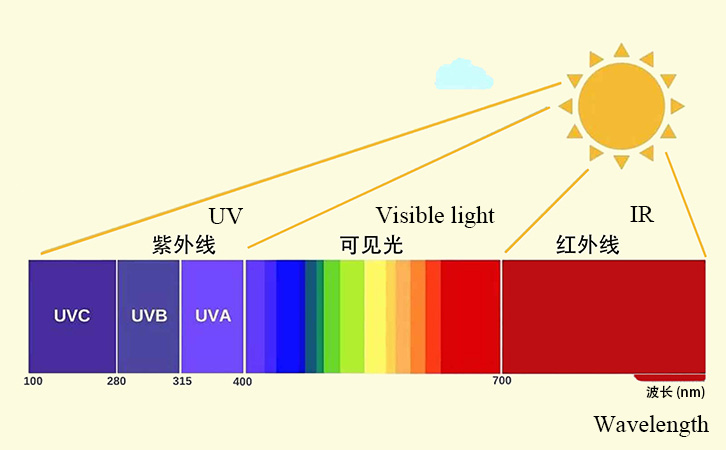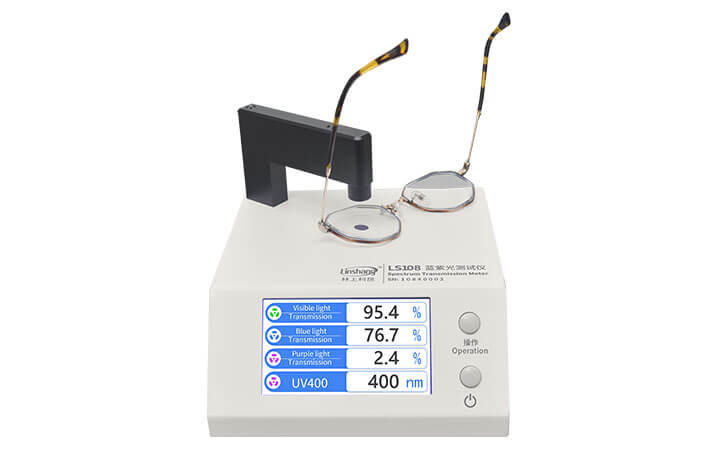UV Cut-off Wavelength of Eyeglass Lenses and UV400 Standard
Whether it is sunny or cloudy throughout the year, ultraviolet rays are present in the sun. Although it is beneficial to the production of vitamin D, the damage caused by ultraviolet radiation to the eyes can’t be ignored. It may cause cataracts and macular degeneration. Eye diseases such as keratitis, so when choosing sunglasses or ordinary glasses, it is generally necessary to choose lenses with anti-ultraviolet properties to protect the eyes. UV 400 standard is an important standard in eyeglasses industry. Transmission meter is recommended to measure the UV 400 performance of the eyeglasses.
I. Chinese spectacle lens industry standard
At present, there is no clear standard for the anti-ultraviolet performance of glasses in our country. It is only required to be harmless to the wearer. Therefore, the identification of the anti-ultraviolet performance of lenses in the glasses industry is different, but the anti-ultraviolet performance of the lens are evaluated by the UV value (UV cut-off wavelength) in most of the standards.
II. What is the UV cutoff wavelength?
Ultraviolet radiation in sunlight propagates in the form of electromagnetic waves. The wavelengths are divided into three main bands from high to low, namely UVA, UVB and UVC, the unit is nanometer (nm), the range of each band is shown in the figure below:

The UV cut-off wavelength is also called the UV value. The maximum transmittance of ultraviolet rays below the UV Cut off wavelength is less than 2%. We can also say that more than 98% of the ultraviolet rays below the UV cut off wavelength can be cut off. It is an important indicator for evaluating whether the lens can effectively block ultraviolet radiation damage. This value must be greater than 315nm. Generally, the UV cut-off wavelength of a lens with anti-ultraviolet performance will be greater than 350nm and less than or equal to 400nm.
III. What is the UV400 standard?
The spectacle lens logos divided by UV value mainly include UV380, UV400, 100% UV absorption, UV anti-ultraviolet, etc. The following are several standards for lenses:
1. UV400
UV 400 means that the UV cut-off wavelength of the lens is 400nm, which means that the maximum transmittance of ultraviolet rays that below 400nm is less than 2% (above 98% is cut off).
2. UV anti-ultraviolet (also called UV380)
UV380 means that the UV cut-off wavelength of the lens is 380nm, which means that the maximum transmittance of ultraviolet rays that below 380nm is less than 2% (98% or more is cut off).
3. 100% UV absorption
100% UV absorption means that the lens has the function of 100% absorption of ultraviolet rays, that is, the average transmittance of the entire ultraviolet band is less than 0.5%.
4. Other standards
Some countries also define UV400 as the ultraviolet light below 400nm wavelength can be blocked from 99% to 100%. EU widely used standard is that ultraviolet light below 380nm wavelength can be blocked by 95%.
IV. How to measure the UV cutoff wavelength?
1. Place the banknote with the anti-counterfeit mark under the ultraviolet currency detector flashlight and put the lens under test in the middle. If the banknote's anti-counterfeit mark is not visible after turning on the flashlight, it means that the lens has a blocking effect on the ultraviolet light emitted by the flashlight However, this method can only make a simple qualitative judgment on whether the lens has anti-ultraviolet effect. It can’t measure the anti-ultraviolet performance of the lens.
2. Use transmission meter to measure UV cut-off wavelength. The instrument has a built-in ultraviolet light source of a certain wavelength. The UV cut-off wavelength is calculated by measuring the ultraviolet transmittance of this wavelength. As shown in the figure below, the purple light transmission is 2.4% (UV rejection rate is 97.6). The UV cut-off wavelength is 393nm, which means that the lens can block more than 98% of ultraviolet rays below the 393nm wavelength. It can also be read from the screen that the light transmittance of the glasses is 95.4% and the blue light transmission rate is 76.7%.


3. Using a spectrophotometer to measure the UV cut-off wavelength is the most accurate way. It can measure the transmittance of the lens to each wavelength of ultraviolet rays, but the equipment is extremely expensive and is rarely used in the spectacle lens industry.
We hope that the above knowledge can help you know more standards in eyeglasses industry and know the performance of the eyeglasses. For more professional knowledge about the light transmittance measurement, please consult us.
- Features of the LS183 UV Transmittance Meter
- Difference between Visible Light Transmission Meter LS183 and LS108H
- Spectacle lens anti-blue light detection---blue-violet light transmittance meter
- Spectrum Transmission Meter for Measuring PC Sheet
- Difference between LS103A and LS183 spectrum transmission meter
- Measuring the Transmittance of a Hemisphere by Plastic Transmittance Meter